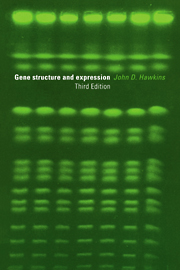Book contents
- Frontmatter
- Contents
- Introduction to the third edition
- Introduction to the second edition
- Introduction to the first edition
- List of abbreviations
- 1 Deoxyribonucleic acid (DNA)
- 2 Ribonucleic acid (RNA)
- 3 Methodology
- 4 Prokaryotic DNA replication and gene expression
- 5 The operon concept
- 6 Eukaryotic gene organisation and replication
- 7 Eukaryotic transcription
- 8 Post-transcriptional processing of RNA
- 9 Oncogenes
- 10 Haemoglobin
- 11 Proteins of the immune system
- 12 Some gene families
- 13 Mitochondrial and chloroplast genomes
- 14 Different and evolving genomes
- Glossary
- Reading lists
- Index
8 - Post-transcriptional processing of RNA
Published online by Cambridge University Press: 05 June 2012
- Frontmatter
- Contents
- Introduction to the third edition
- Introduction to the second edition
- Introduction to the first edition
- List of abbreviations
- 1 Deoxyribonucleic acid (DNA)
- 2 Ribonucleic acid (RNA)
- 3 Methodology
- 4 Prokaryotic DNA replication and gene expression
- 5 The operon concept
- 6 Eukaryotic gene organisation and replication
- 7 Eukaryotic transcription
- 8 Post-transcriptional processing of RNA
- 9 Oncogenes
- 10 Haemoglobin
- 11 Proteins of the immune system
- 12 Some gene families
- 13 Mitochondrial and chloroplast genomes
- 14 Different and evolving genomes
- Glossary
- Reading lists
- Index
Summary
Termination of transcription
Almost all eukaryotic mRNAs, with the notable exception of those for his tones, have a sequence of adenyl residues [the poly(A) tail] added post-transcriptionally in the nucleus by the action of the enzyme poly(A) polymerase. Typically, this tail contains about 50–250 A residues that increase the stability of mRNAs by protecting them against degradation by ribonucleases.
Although signals in the DNA directing RNA polymerase to definite sites for initiation of transcription are known, the mechanism for ending transcription is not well understood. Downstream from the termination codon there is always a sequence of nucleotides that is transcribed and appears in the mRNA but is not translated. This is very variable in length and may, sometimes, exceed 1000 nt. The sequence AATAAA is present in nearly all animal protein-coding genes about 10–30 nt upstream from the site of poly(A) addition. Natural or artificial mutation of this sequence interferes with proper 3′-end processing and may also cause increased transcription past the normal region of termination. Thalassaemias (Chapter 10.2) can arise by mutation of AATAAA to AATAAG or AACAAA in the poly-adenylation signal of the β-globin gene.
The AAUAAA sequence in a pre-mRNA is a nucleation site where a protein complex is built up. This contains the Cleavage and Poly-adenylation Stimulatory Factor (CPSF) and the Cleavage Stimulatory Factor, both of which are oligomeric. The latter also contacts a sequence rich in U, or G and U residues a little way downstream.
- Type
- Chapter
- Information
- Gene Structure and Expression , pp. 110 - 124Publisher: Cambridge University PressPrint publication year: 1996
- 1
- Cited by



